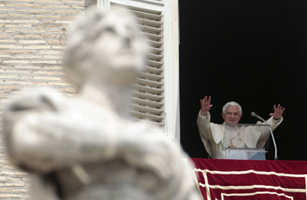By Amy Sullivan
TIME
May 19, 2011
http://www.time.com/time/nation/article/0,8599,2072574,00.html
 |
| Pope Benedict XVI greets the crowd attending the Regina Coeli prayer in St. Peter's Square on May 15, 2011 |
A sweeping study released on Wednesday covering 60 years of sexual-abuse allegations against the U.S. Roman Catholic Church identified no definitive cause for the crisis and proposed changes that would require radical reforms to its hierarchy.
The 300-page report is the product of five years of work by researchers at the John Jay College of Criminal Justice in New York City. It comes at a time when the Catholic Church continues to be rocked by the trauma of clergy abuse, both in Europe and in the U.S., most recently in Philadelphia. (See "Vatican Gets Tough on Child Abuse, but Not Tough Enough.")
Few Catholics are likely to be satisfied by the report. Its findings undercut some favorite arguments of critics and depict a church leadership more focused on protecting abusers than helping victims. Researchers compared American dioceses to insular police departments that protect corrupt or abusive cops within their ranks.
Many liberal activists have long argued that the church's reliance on an all-male, celibate priesthood encourages abuse by providing no outlet for natural sexual desire. For their part, conservatives like Bill Donohue of the Catholic League link cases of sex abuse to the growing number of gay priests.
They're both wrong, according to the John Jay researchers. Incidents of clergy abuse dropped dramatically starting in the 1980s, even though the celibacy requirement has remained. And researchers note that a rise in the number of gay seminarians and priests corresponded with "a decreased incidence of abuse — not an increased incidence of abuse." (See "Catholics Take Boehner to Task.")
In fact, researchers could not identify any individual characteristics that formed a profile of an abusive priest after studying psychological and intelligence test data, and developmental and sexual histories of abusers. "Individual characteristics did not predict that a priest would commit sexual abuse of a minor," the investigators write. "Rather, vulnerabilities, in combination with situational stresses and opportunities, raise the risk of abuse."
Those situational stresses, the report concludes, included vast social changes and shifting sexual mores in the 1960s and '70s. "The increased frequency of abuse" during that period, says lead investigator Karen Terry, "was consistent with patterns of increased deviance in society during that time."
As for opportunities, the researchers determined that priests didn't single out male victims or even young victims. Abusive clergy were more likely to victimize boys because they were the ones serving as altar boys, and coming into contact with priests through parochial schools and recreational activities. As with prison rape, the aggressors weren't necessarily gay because their victims were of the same sex. They just chose the weakest and most available prey. (See the top 10 Vatican pop-culture moments.)
This explanation is already roiling influential Catholics. In an interview with the New York Times, Donohue accused the report's authors of "go[ing] through all sorts of contortions to deny the obvious — that obviously, homosexuality was at work." Abuse victim advocates are also suspicious of the findings; they note that the church has in the past blamed the abuse crisis on the era of free love and hippies. And they question whether the U.S. Conference of Catholic Bishops, which covered half of the $1.8 million cost of the study, had any influence over its findings.
There is some good news in the report. It concludes that the church did take steps that led to a sharp decline in abuse cases over the past few decades. The most significant change was a reform of seminary training to better prepare future priests for a life of celibacy.
The report's ultimate recommendation will sound familiar to anyone who has studied an institution in crisis: enact uniform policies that encourage transparency and accountability. But this is the American Catholic Church, in which each bishop runs his diocese largely free from scrutiny and oversight. Just last week, the head of the Philadelphia Archdiocese's in-house review board publicly complained that church leaders had been selective in handing over sex-abuse allegations rather than allowing the board to sift through every complaint. (Read about Pope Benedict XVI's daily life.)
Perhaps the best evidence that church reforms are still far off came on May 16 when the Vatican issued new guidelines for bishops to consult when dealing with sex-abuse cases. The guidelines are voluntary, meaning bishops will continue to have the final say over all matters within their individual dioceses. The bishop remains king, reporting only to the Pope and God.
Any original material on these pages is copyright © BishopAccountability.org 2004. Reproduce freely with attribution.